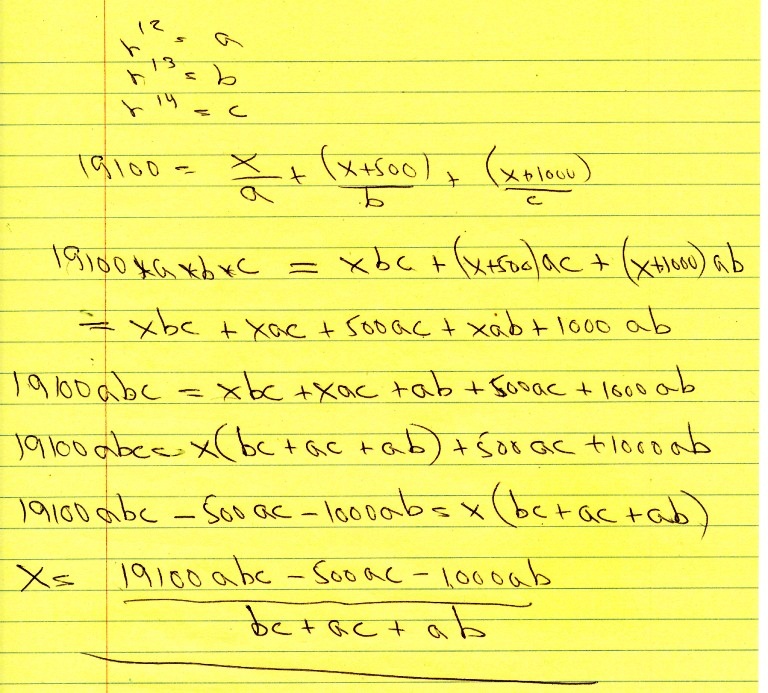|
Question 1188360: Jill has an investment opportunity that will make three annual payments, the first coming 12 years from now. The payments will increase by 500 dollars from one payment to the next. If the nominal rate is 7.4 percent convertible quarterly and the present value of the investment now is 19100 dollars, how large is the first payment
Answer by Theo(13342)   (Show Source): (Show Source):
You can put this solution on YOUR website! i get:
16010.13803 equals the payment in the 12th year.
16510.13803 equals the payment in the 13th year.
17010.13803 equals the payment in the 14th year.
i couldn't think of any way to solve this other than by brute force.
here's how i did it.
i set up the formulas as shown in the attached worksheet.

what you see on top is:
r^12 = a
r^13 = b
r^14 = c
r is the effective interest rate growth factor per year.
it was created in the following manner.
the nominal annual interest rate is 7.4%. per year.
divide that by 100 to get the nominal annual interest rate of .074 per year.
divide that by 4 to get the effective interest rate per quarter = .074/4 = .0185.
the effective growth factor per quarter is equal to 1 plus that = 1.0185.
raise that to the 4th power to get the effective growth factor per year = (1.0185)^4 = 1.076078944.
raise that to the 12th power to get the effective growth factor for 12 years.
raise that to the 13th power to get the effective growth factor for 13 years.
raise that to the 14th power to get the effective growth factor for 14 years.
what you wind up with is:
a = r^12 = 1.076078944 ^ 12 = 2.410624689
b = r^13 = 1.076078944 ^ 13 = 2.594022469
c = r^14 = 1.076078944 ^ 14 = 2.791372958
the reason i used a, b, and c is so that i could create the formula without getting writer's cramp.
as it turned out, it was still a chore, but you can see the results of the effort in finding the value of x on the last line of the worksheet.
it was just them a matter of replacing a, b, and c with their respective values to get the the value of x and, from there, the value of x + 500 and the value of x + 1000.
the actual calculations were done in excel.
here's what the excel worksheet looked like.


the internal rate of return of the cash flow is the same as the effective annual interest rate.
the internal rate of return is the interest rate that gives you a present value of 0.
to get that, the sum of the present value of the future positive cash flows had to be equal to 19100.
when that occurred, the present value of the cash flows was (19100 - 19100 = 0).
the fact that the internal rate of return was the same as the effective annual interest rate told me that the calculations were done successfully.
i could have completed the problem without using excel, but i found that excel gave me the answers i needed while allowing me to document the steps.
if you just follow the worksheet and the formula for x, you should be able to duplicate the result.
let me know if you have any questions.
theo
|
|
|
| |